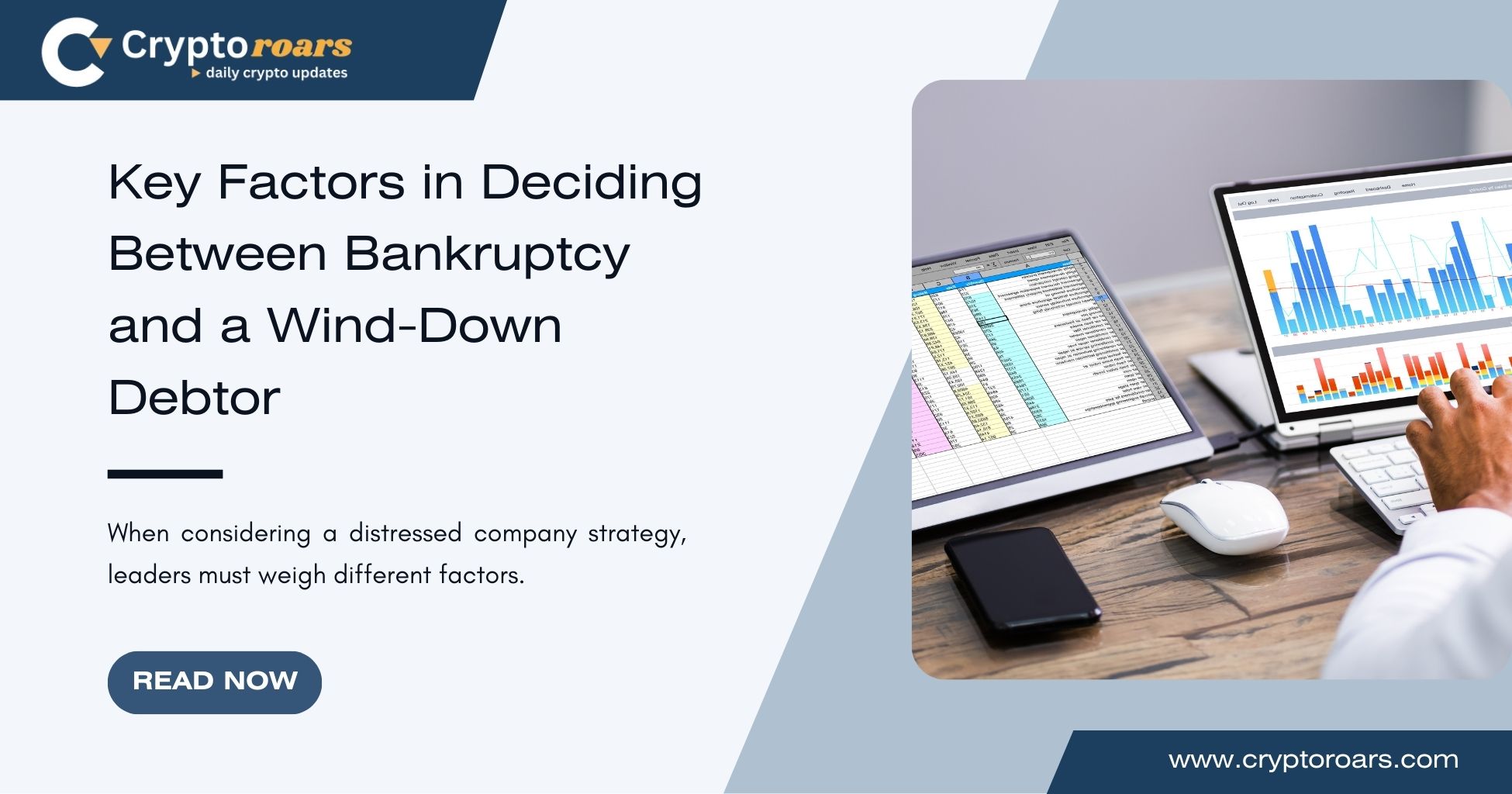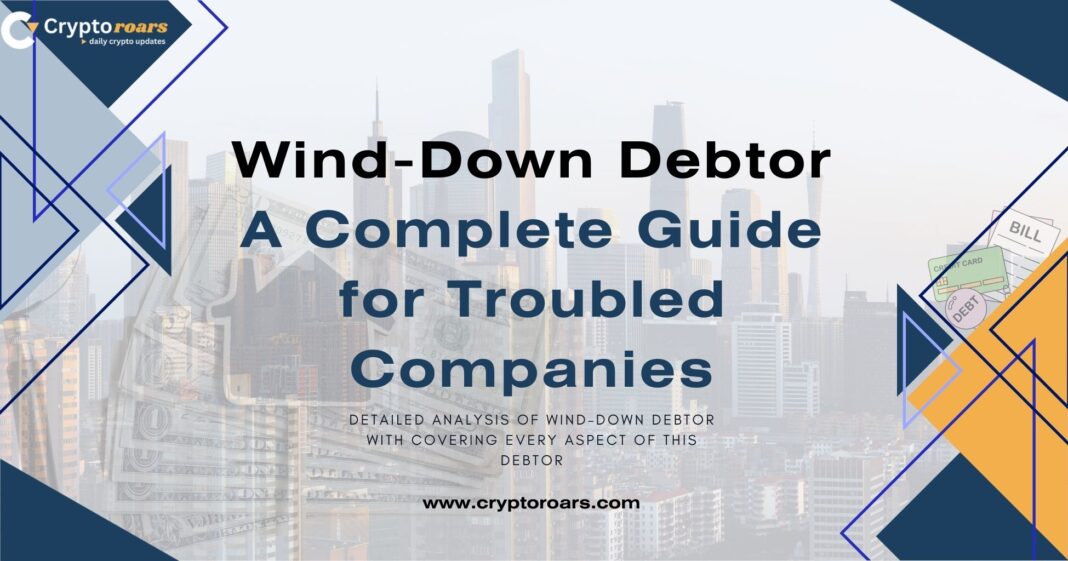When businesses in the USA experience financial distress, decision-makers often weigh options like Chapter 11 bankruptcy or Chapter 7 bankruptcy. Yet, many companies now explore the wind-down debtor path. This strategy allows a distressed firm to close operations in an orderly way, often without the heavy burden of extended legal proceedings. A wind-down debtor approach may involve asset distribution and creditor equality, helping companies manage debts while protecting stakeholders. For troubled companies seeking solutions, this method provides flexibility and control.
A wind-down debtor plan can serve as a cost-effective alternative to a clean break through bankruptcy. It often includes structured creditor negotiations, careful handling of liabilities, and even elements of company dissolution. Because the wind-down debtor method balances closure with responsibility, it has become a practical option for firms looking to minimize reputational damage while still fulfilling financial obligations.
What is a Wind-Down Debtor?
A wind-down debtor is a business that chooses to shut down operations in a controlled way rather than filing for bankruptcy. This approach focuses on company dissolution, the liquidation of assets, and asset distribution among creditors without a court order. While bankruptcy involves an automatic stay, a bankruptcy trustee, and legal oversight, a wind-down debtor plan is guided by management.
In simple terms, a wind-down debtor means the company still pays debts but avoids the heavy process of legal proceedings. Many view this as a cost-effective alternative because it can reduce legal fees, paperwork, and reputational damage compared to bankruptcy court. Businesses with cooperative creditors often find this method more flexible and humane.
Bankruptcy vs. Wind-Down Debtor Approach
The bankruptcy vs. wind-down decision is one of the hardest choices for troubled companies seeking solutions. Bankruptcy offers a clean break through bankruptcy, legal protection, and formal litigation risk management. For example, once you file, creditors must stop their debt collection halt under the law. However, the process is expensive, public, and sometimes damaging to long-term reputation.
On the other hand, a wind-down debtor plan provides more control. Management decides how to handle creditor negotiations, methodical asset sales, and manage creditor settlements. The process is private and less formal, but it carries risks because creditors may still sue if they feel unfairly treated. This is why understanding the advantages of a wind-down process and the disadvantages of a wind-down is key before leaping.
Key Factors in Deciding Between Bankruptcy and a Wind-Down Debtor

When considering a distressed company strategy, leaders must weigh different factors. Financial health, type of debt, and willingness of creditors all play major roles. If the company lacks funds even to pay closure costs, bankruptcy may be inevitable.
Factors to review include:
- Market and industry conditions in distress (whether assets can be sold quickly).
- Litigation protection (bankruptcy offers more safeguards than wind-down).
- Control during dissolution (wind-down gives management power; bankruptcy shifts control to the trustee).
- Shareholder impact (bankruptcy may eliminate shareholder value, while a wind-down allows some influence).
- Regulatory environment considerations (industries like finance or healthcare may face stricter rules).
Wind Down Planning Process
The planning stage is critical for a wind-down debtor. A well-structured plan prevents chaos, reduces losses, and protects relationships. Companies usually start by assessing all assets and debts, then design a methodical asset sale strategy. This ensures maximum value recovery before closure.
Planning also requires mapping out strategic financial decisions for distressed firms. These include negotiating settlements, prioritizing creditor equality, and ensuring regulatory compliance. Some firms also consult financial advisors who provide expert advice for financial restructuring. Without careful planning, the risk of lawsuits, confusion, and loss of trust grows significantly.
Common Scenarios Leading to a Wind-Down Debtor
A business may choose the wind-down route for several reasons. Sometimes revenues shrink due to declining markets, leaving no room for a business turnaround. Other times, regulatory environment considerations make ongoing operations too costly.
Typical scenarios include:
- Technology firms with outdated products that can’t compete.
- Retail chains are suffering from minimizing losses in declining markets.
- Startups that ran out of funding and cannot restructure their debts.
- Companies are facing multiple lawsuits without strong litigation protection.
Each case is unique, but all share a theme: finding closure in a controlled, less damaging way.
Risk Management in a Wind-Down Debtor Strategy
Risk management plays a big role in any wind-down debtor plan. Since the process is not protected by a court like Chapter 11 bankruptcy, there’s always a chance of lawsuits. Smart companies use litigation risk management techniques to reduce exposure. These include documenting all creditor agreements, following industry regulations, and ensuring fair asset distribution.
Another risk involves employees. The impact on employees and stakeholders is huge in these situations. Clear communication, fair severance, and assistance with job placement can reduce backlash. A company that handles closure with care may even maintain goodwill for future ventures by the same leadership.
Impact Assessment of a Wind-Down Debtor
The impact of a wind-down debtor strategy varies depending on the size of the business. For small firms, it often provides closure with dignity. For larger corporations, it affects shareholders, lenders, suppliers, and workers. Residual liabilities may remain if debts exceed assets, creating long-term challenges.
A helpful way to understand the differences is through comparison.
| Impact Area | Bankruptcy (Chapter 7/11) | Wind-Down Debtor Approach |
| Creditor Protection | Strong due to the automatic stay | Limited, relies on creditor negotiations |
| Control | Trustee controls the process | Management retains control |
| Reputation | Public stigma, but structured | Private, avoids some reputational damage |
| Employee Outcomes | Varies, court-supervised | Depends on the company’s planning |
| Costs | High legal fees | Lower-cost, more effective alternative |
This table shows why some firms prefer the flexibility of winding down rather than heading straight to bankruptcy court.
Operational Steps of a Wind-Down Debtor
The operational process usually begins with asset distribution. Companies must sell equipment, inventory, or intellectual property in a methodical asset sale. Proceeds then go toward paying creditors, with the aim of creditor equality.
After this, firms address managing creditor settlements. This step requires skill in negotiating with fewer creditors whenever possible. Businesses that manage communication well often avoid expensive disputes. Finally, closure involves legal filings for company dissolution under state-law wind-down procedures. This ensures compliance with rules and reduces future residual liabilities.
Case Studies: Companies Choosing a Wind-Down Debtor Strategy

Several well-known companies have chosen to wind down rather than file for bankruptcy. One tech startup in California, for example, opted for a corporate wind-down after failing to secure new investment. Instead of filing for Chapter 11 bankruptcy, it sold its patents, paid suppliers, and supported employees in finding new work. This approach avoided long legal fights and showed the advantages of a wind-down process.
In another case, a mid-size retail chain chose this strategy after years of declining sales. Management believed bankruptcy would cause severe reputational damage, so they closed stores gradually, liquidated inventory, and settled debts privately. While not easy, this distressed company strategy minimized losses and gave creditors better outcomes compared to bankruptcy.
As one business lawyer stated:
“Choosing a wind-down debtor path is about dignity, fairness, and control. It’s not painless, but it can be far more humane than court-driven solutions.”
Final Thoughts: Is a Wind-Down Debtor the Right Path?
Deciding whether to use a wind-down debtor plan or bankruptcy is one of the toughest challenges for companies in crisis. Bankruptcy may provide litigation protection, legal structure, and a chance for business turnaround under Chapter 11 bankruptcy. But it also carries high costs, court oversight, and long-term stigma.
On the other hand, a wind-down offers advantages of a wind-down process, such as flexibility, lower expenses, and more control during dissolution. Yet the disadvantages of a wind-down include exposure to lawsuits, lack of legal shields, and uneven outcomes if creditors refuse to cooperate.
Every situation is unique. Companies must review market and industry conditions in distress, consider the long-term view of liabilities, and seek expert advice for financial restructuring. With careful planning, a wind-down debtor approach can allow a struggling business to close with fairness, protect relationships, and prepare for a healthier long-term business outlook.
FAQs About Wind-Down Debtor
-
What is a wind-down debtor in simple terms?
A wind-down debtor is a company that shuts down in an orderly way, sells assets, and pays creditors without going through bankruptcy court.
-
Is a wind-down debtor always better than bankruptcy?
No. Bankruptcy provides stronger legal protections and an automatic stay, while a wind- down offers flexibility. The bankruptcy vs. wind-down decision depends on financial and legal factors.
-
What happens to employees in a wind-down debtor plan?
Outcomes depend on management. Many firms provide severance, job placement help, and transparency to reduce the impact on employees and stakeholders.
-
Do creditors get paid in a wind-down debtor process?
Yes, through asset distribution and settlements. However, they may not receive full repayment, especially if debts exceed the liquidation value.
5. Can a wind-down debtor protect the company’s reputation?
Yes, often better than bankruptcy. By choosing a corporate wind-down, businesses avoid public court cases and reduce reputational damage.
For more information, keep visiting cryptoroars.com


